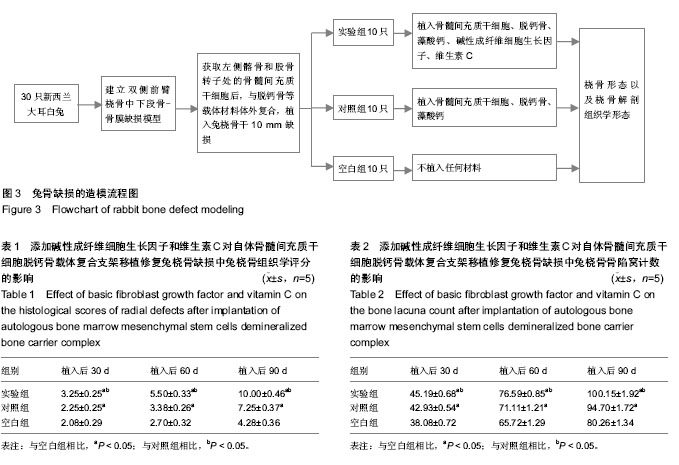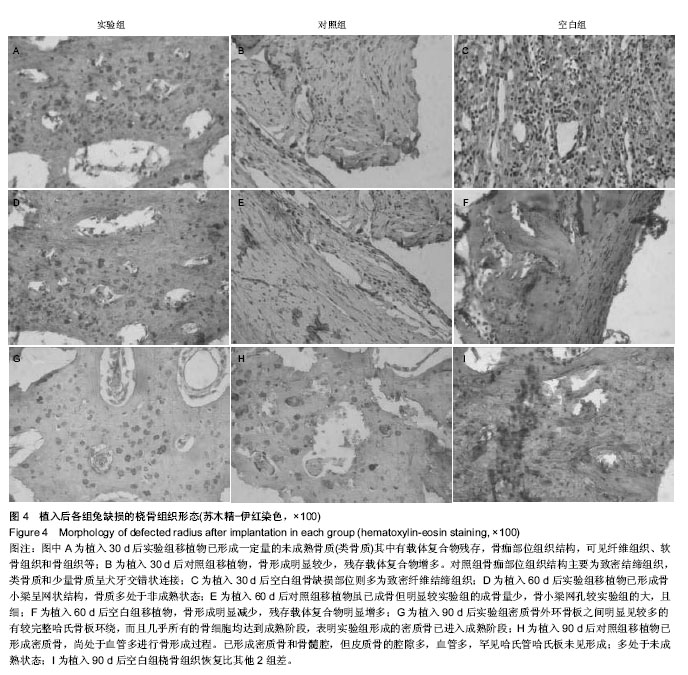| [1] 郭宜姣,李文华.骨缺损修复生物工程研究进展[J].中国骨质疏松杂志,2014,20(8):988-993.
[2] 张志宏,刘志礼,高志增,等.骨修复替代材料修复骨缺损的选择与应用[J].中国组织工程研究,2012,52(16):9836-9843.
[3] Riggenbach MD, Jones GL, Bishop JY. Open reduction and internal fixation of clavicular nonunions with allograft bone substitute. Int J Shoulder Surg. 2011;5(3):61-67.
[4] Kajdaniuk D, Marek B, Foltyn W, et al. Vascular endothelial growth factor (VEGF) - part 2: in endocrinology and oncology. Endokrynol Pol. 2011;62(5):456-464.
[5] 曾宪利,杨春露.修复临界节段性骨缺损:组织工程骨支架形态及对种子细胞负载有效性的影响[J].中国组织工程研究,2014, 18(29):4717-4723.
[6] 师彬,杨武斌,王平.骨髓间充质干细胞诱导分化成骨细胞的研究现状[J].中国实验方剂学杂志,2014,20(19):228-231.
[7] 陈佳滨,李强,茹嘉,等.腺病毒介导BMP-2和EGFP基因转染兔骨髓基质干细胞及种植脱钙骨的体外观察[J].中国骨质疏松杂志, 2014,20(8):869-874.
[8] 徐斌,周亮,王英明,等.同种异体脱钙骨与骨髓间充质干细胞关节腔内共培养:与同腔软骨性状的对比[J].中国组织工程研究, 2014,18(8):1165-1171.
[9] Bai Y, Yin G, Huang Z, et al. Localized delivery of growth factors for angiogenesis and bone formation in tissue engineering. Int Immunopharmacol. 2013;16(2):214-223.
[10] Bai Y, Yin G, Huang Z, et al. Localized delivery of growth factors for angiogenesis and bone formation in tissue engineering. Int Immunopharmacol. 2013;16(2):214-223.
[11] 谭志军,陈艳,张翠萍,等.微小RNA调控骨髓间充质干细胞分化的研究进展[J].中华实验外科杂志,2014,31(6):1389-1390.
[12] 邢承忠,洪晶,顾绍峰,等.兔骨髓间充质干细胞的分离、培养和鉴定[J].中国医科大学学报,2008,37(1):4-6.
[13] 李进,郑冬,杨述华.同种异体脱钙骨基质作为骨组织工程载体的实验研究[J].华中科技大学学报(医学版),2005,34(4):465-468.
[14] 雷鸣,刘世清,刘宇兰,等.藻酸钠微球中骨髓间充质干细胞向软骨细胞的定向分化[J].中国组织工程研究与临床康复,2008, 12(19): 3659-3662.
[15] 李东亚,郑欣,邱旭升,等.新西兰兔桡骨骨缺损动物模型的制作[J].中华实验外科杂志,2013,30(9):2012.
[16] Zhang M, Wang GL, Zhang HF, et al. Repair of segmental long bone defect in a rabbit radius nonunion model: comparison of cylindrical porous titanium and hydroxyapatite scaffolds. Artif Organs. 2014;38(6):493-502.
[17] 张屹,陈建常,史振满.异种骨支架及其衍生材料治疗骨缺损的研究现状与进展[J].中国矫形外科杂志,2014,22(14):1277-1279.
[18] 黄旋平,谢庆条,江献芳,等.慢病毒载体介导的基因治疗在骨缺损修复中的研究进展[J].中国矫形外科杂志,2014,22(14): 1284-1287.
[19] Lyons FG, Gleeson JP, Partap S, et al. Novel microhydroxyapatite particles in a collagen scaffold: a bioactive bone void filler? Clin Orthop Relat Res. 2014;472(4): 1318-1328.
[20] Tyndall A. Application of autologous stem cell transplantation in various adult and pediatric rheumatic diseases. Pediatr Res. 2012;71(4 Pt 2):433-438.
[21] Huang LF, Li R, Liu WG, et al. Dynamic culture of a thermosensitive collagen hydrogel as an extracellular matrix improves the construction of tissue-engineered peripheral nerve. Neural Regen Res. 2014;9(14):1371-1378.
[22] 代志鹏,许伟华,杨述华,等.人骨髓间充质干细胞的生物学特性及成骨诱导分化的研究[J].中国矫形外科杂志,2014,22(15): 1402-1407.
[23] 杨武斌,王平,师彬.骨髓间充质干细胞的成骨性诱导[J].中华中医药学刊,2014,32(9):2158-2160.
[24] Chen WC, Yao CL, Wei YH, et al. Evaluating osteochondral defect repair potential of autologous rabbit bone marrow cells on type II collagen scaffold. Cytotechnology. 2011;63(1): 13-23.
[25] Getgood AM, Kew SJ, Brooks R, et al. Evaluation of early-stage osteochondral defect repair using a biphasic scaffold based on a collagen-glycosaminoglycan biopolymer in a caprine model. Knee. 2012;19(4):422-430.
[26] McBane JE, Sharifpoor S, Cai K, et al. Biodegradation and in vivo biocompatibility of a degradable, polar/hydrophobic/ionic polyurethane for tissue engineering applications. Biomaterials. 2011;32(26):6034-6044.
[27] 马立坤,叶鹏,邓江,等.丝素蛋白/壳聚糖/纳米羟基磷灰石骨组织工程支架材料的体外细胞毒性评价[J].西部医学,2014,26(8): 975-977.
[28] 耿海霞,封伟,钱君荣,等.羟基磷灰石-凝胶支架复合成骨细胞修复兔颅骨缺损的组织学评价[J].临床口腔医学杂志,2014,30(9): 519-521.
[29] 胡金龙.组织工程学技术治疗骨缺损的最新研究进展[J].中国矫形外科杂志,2013,21(2):150-153.
[30] 孙翊夫,康明阳,候婷婷,等.BMP-2和VEGF在大鼠骨缺损修复过程中的表达和意义[J].临床和实验医学杂志,2014,13(6): 432-435.
[31] 郑军,汤伟忠,齐新生.新型双相钙磷陶瓷复合骨形态发生蛋白及碱性成纤维细胞生长因子修复兔骨缺损[J].中国组织工程研究与临床康复,2010,14(42):7791-7794. |


.jpg)
.jpg)